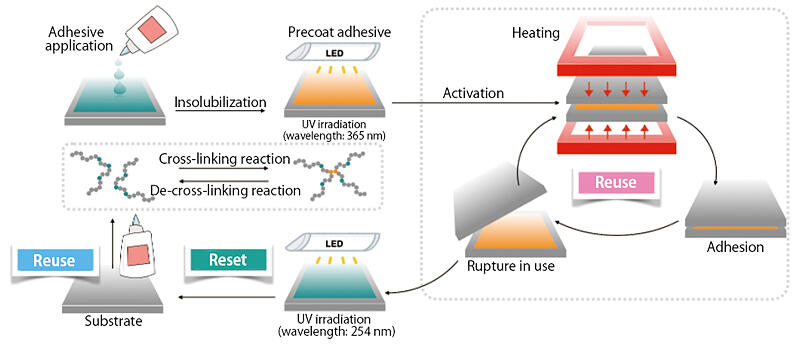With increasing focus on the concept of a circular society, a new joining technology called 'dismantlable adhesion' is attracting attention. This technology allows for sufficient adhesion during use and easy peeling upon the application of external stimuli after use. However, achieving both strong adhesion and easy peeling is difficult because adhesion and peeling are contradictory phenomena.
A research team led by Field Director Masanobu Naito of the Research Center for Macromolecules and Biomaterials at the National Institute for Materials Science (NIMS) has focused on 'caffeic acid,' which triggers reversible cross-linking and de-cross-linking reactions when irradiated with ultraviolet (UV) light of different wavelengths. When a polymer incorporating caffeic acid was coated on a substrate and irradiated by UV light with a peak wavelength of 365 nm (one-billionth of a meter), a strong insoluble adhesive layer was formed through a cross-linking reaction. When the sample with the adhesive layer was cut and heated, the adhesive layer regained its initial adhesive strength; the performance did not deteriorate even after repeating this operation for more than 30 times.
In addition, when the adhesive layer was irradiated with ∼254 nm UV light, which has a higher energy than 365 nm ultraviolet light, the sample returned to the same state as that before coating because of the de-cross-linking reaction triggered by caffeic acid. Both the adhesive and substrate could be recovered and reused. Furthermore, the catechol group of caffeic acid endows strong adhesive strength and recyclability even on substrates, in water, and in environments wherein adhesion with ordinary adhesives, such as fluoropolymers, is difficult.
Adhesives that can be recycled and reused using light are expected to be applicable in diverse fields, including electronics, transportation equipment, medical equipment, and infrastructure repair. Furthermore, the new construction technology, called underwater remote adhesion, will contribute to the realization of next-generation social infrastructure robots and remote medical care.





